
 Mark
of the first synagogue in Padua. Since after a fire it was rebuilt so the appearance
seems new. On the wall there is a plate monument. Currently it's impossible to
visit inside.
Mark
of the first synagogue in Padua. Since after a fire it was rebuilt so the appearance
seems new. On the wall there is a plate monument. Currently it's impossible to
visit inside.Padua is a city of many monuments and many works of art. So there are many famous sights to see. However, there are many other many beautiful monuments of the city which will not appear on guide books. Here I introduce these attractive spots which are integrated within the city landscapes.
 The
road leading into the ghetto area. The flag is a sign.
The
road leading into the ghetto area. The flag is a sign.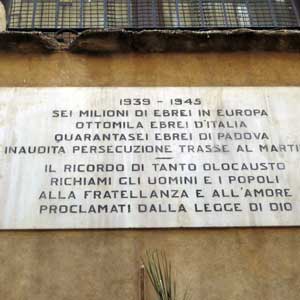 Inscription
of the ruin of one synagogue. The synagogue of the ghetto in Venice has the same
thing.
Inscription
of the ruin of one synagogue. The synagogue of the ghetto in Venice has the same
thing.![]()
"Ghetto" refers isolated areas allowed the Jews to live under the Jewish
persecution by Christians of long time ago.
It's said that the Venetian Ghetto was the oldest in Europe, but also this ghetto of Padua under the Republic of Venice has a very long history.
In Padua you can see its vestiges of the city center. The first synagogue (Jewish church) was built in 1548 and from that moment the history of the ghetto began. Here German Jewish believers had been collected.
The second synagogues was built in 1892, and Italian and Spanish Jewish believers had been collected in this area. It's said that inside the synagogues there were churches and schools.
The synagogue with distinctive red walls was fired by anti-Jewish in 1943 during the first World War II. It was currently rebuilt in 1998 by the Jewish believers in Padua.
Now it's impossible to see inside but these two buildings of synagogues have plates with the phrase against persecution of the Jews at that time. You can feel the remnants of those days.
Location is the area just south of Piazza Erbe. Since there is a flag at the entrance of the ghetto street, you can recognize it immediately.
Two synagogues are located in Via delle Piazze and in Via San Martino.
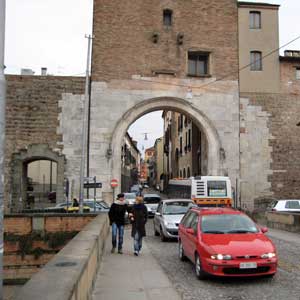 You
can still see the remaining walls of the town everywhere. Molino Gate Bridge.
It's located in Via Dante, in the north of the old city.
You
can still see the remaining walls of the town everywhere. Molino Gate Bridge.
It's located in Via Dante, in the north of the old city.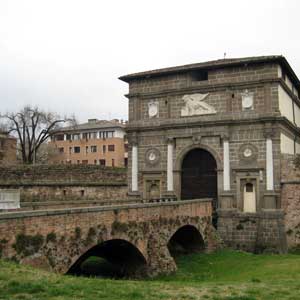 Savonarola
gate (Porta Savonarola) of 1500s. A lion, the symbol of the Republic of Venice,
has been carved.
Savonarola
gate (Porta Savonarola) of 1500s. A lion, the symbol of the Republic of Venice,
has been carved.![]()
It means a walled city. The urban structure to protect the city against the invasion
of enemies making big walls around the city and doing autonomous activity inside.
It's seen that many Italian city have these structures. Also here in Padua, where
you can still see the remnants of the history.
The first construction of the walls surrounding the old city was built from 1195 to 1210. Then other walls were added around the castle of Carraresi family who ruled Padua since 1400. The last and larger structure were built in 1500s under the control of Republic of Venice, in order to expand the territory.
Still now, the original gates and bridges built at that time remain. There are six gates at the walls surrounding the old city. They are components that make you feel the atmosphere of the past.
One of the most important sites is the Gate and Bridge of Molino (Porta e Ponte Molino).
It's located on Via Dante, which had been constructed in BC 40-30, at the time of the Roman period. It had been the main street of Padua. The first bridge was built at that time, but it was subsequently rebuilt in the 12th century. The Morino gate and this gate Pontecorvo (Porta Pontecorvo) remind still now.
The Molino gate has a very interesting story. In 1610, Galileo Galilee discovered Jupiter building an observatory at the top of this gate.
Now normal cars and people pass here. Actually it's a "Porta (Gate)" which connects the past and modern period.

Let's look for traces of Galileo at the Molino gate!
On the arch of the Molino gate there is a plate monument to praise the achievements of Galileo. It's carved "From this tower Galileo found a lot of streets of the sky (Da questa torre GALILEO molta via de cieli svelo) )''.
It's romantic to imagine that also Galileo was watching the sky from here 400 years ago.
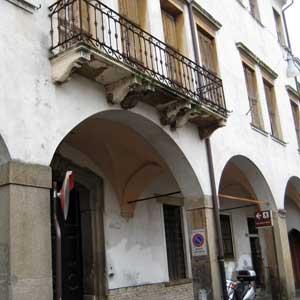 Exterior
of the house of Galileo. Inside is covered by frescoes of 1400-1500s.
Exterior
of the house of Galileo. Inside is covered by frescoes of 1400-1500s.![]()
Here Galileo Galilee had lived in this house in the late 1500s. It's said that
he had lived in several places in Padua, and one of them is here. However if
you visit this place really, you would say "Huh? Is it here?",,,, because
it's a normal building. Since there is a sing on the street you'll recognize.
Walk north on the extending street Via del Santo from the church of Sant'Antonio, and veer to the east street which has the name of Galileo (Via G. Galilei).
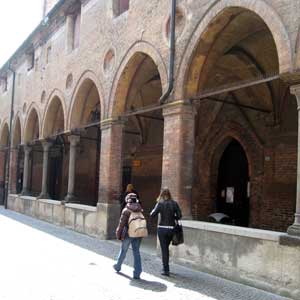 Old
Porticoes of the St. Francis Street
Old
Porticoes of the St. Francis Street ![]()
In Padua there are many porticoes around the streets, and make a part of the
beauty of the town landscape.
It is characterized by the constant line at intervals round pillar, and between the pillars there are beautiful arches. My best personal recommendation is the portico of Via San Francesco.
This street itself is very old and historic in the city. This street has old churches and hospitals and continues to the via G. Galilee and the church of St. Antonio. In addition, this street goes to the gate of Pontecorvo of Roman times. It was one of the main streets at that time. It's so beautiful, please take a walk here, all means!!
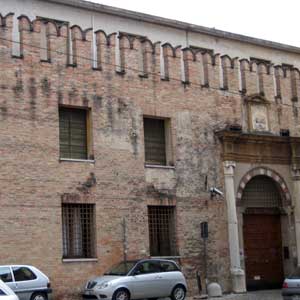 Vescovado.
It is a very beautiful building. Nearby there are also shops of religious goods.
Vescovado.
It is a very beautiful building. Nearby there are also shops of religious goods.![]()
Please come back around the Cathedral. Tower rises behind the church was a building
where the famous poet Petrarch lived temporary in the 1300s. Its style is called
Canonical, Romanesque style.
Also, you can see Vescovado built in 1485. It means "Bishop Museum" but actually it's a religious library and Latin books written by hand in 12th century are stored. Both are very beautiful buildings.
The house where Petrarch had finished his life is located in the suburbs of Padua, Arquà Petrarca.
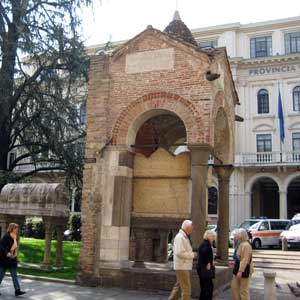 Antenore
grave in front of the city hall of Padua.
Antenore
grave in front of the city hall of Padua.![]()
A grave of a legend person is situated in the center of the city, suddenly. It's
said that Antenore is an ancient Greek, who crossed the Adriatic from Troy, shipwrecked
on Adorea seaside town northeast of Padua, and set up the city of Padua. He can
be considered as a creator of Padua more than 3000 years ago. However, only the
legend tells that. It may be a part of the bone of a soldier from the German
or Hungarian after the collapse of Roman Empire during the 3rd-5th century.
The building that stands behind the monument is a prefecture of Padua. Earlier it was used as the court but originally it had been a convent of St Stefano.
The building across the street was a dwelling of Dante. He was protected by the Carraresi family running from Florence to Padua.
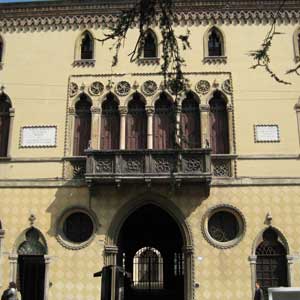
Greatest poet of Italian literature, Dante gave birth to the Renaissance
Dante
was forced from Florence and protected by Carraresi family in Padua.
The
plate says that.
Mark of the first synagogue in Padua
The first synagogue (Jewish church) was built in 1548 under the persecution of Jews, more than 400 years ago. After the fire of anti-Jewish during the World War II, it was rebuilt so the outside seems new. However, there is a plate monument on the wall to remember history forever. Currently, you can not visit inside.